Abstract
Methods
This study was based on data from chronic disease management surveys of Incheon. The surveys were conducted from 12 Sept 2005 to 7 Oct 2005 on 5,144 households using proportional stratified sampling methods. Three questionnaires were performed on all study subjects. All analyses were done using SPSS version 11.5.
Results
Out of 16,623 subjects, the mean age was 34.5±20.2 (years, ±SD). The crude prevalence rate of musculoskeletal diseases were as follows: osteoarthritis 3.2%, rheumatoid arthritis 1.1%, spondyloarthropathy 0.3%, gouty arthritis 0.1%, Behcet's disease 0.04%, herniated disc 1.1%, and osteoporosis 0.8%. Age-standardized prevalence of rheumatoid arthritis was 1.6%, and osteoarthritis 5.2%. The prevalence of rheumatoid arthritis and osteoarthritis tended to be higher among older age groups, low socioeconomic/education state, and homemakers. The age-standardized prevalence of arthritis was higher in rural than in urban area. There were more concurrent chronic diseases such as hypertension or diabetes mellitus in the arthritis group than in the whole population. Questionnaires were performed on subjects with musculoskeletal disease. It revealed chronic arthralgia at 3%, spine arthralgia 2.5%, and chronic myalgia 2.8%.
Conclusion
The crude prevalence of rheumatoid arthritis and osteoarthritis were 1.1% and 3.2% (age-standardized, 1.6% and 5.2%), respectively. The prevalence of musculoskeletal diseases in Incheon is much lower than previously-reported data indicate. These differences should be confirmed by further epidemiological survey. The prevalence of arthritis is higher in populations of old age, low socioeconomic state, and rural areas.
References
1. Centers for Disease Control and Prevention (CDC). Prevalence of disabilities and associated health conditions among adults-United States, 1999. MMWR Morb Mortal Ekly Rep. 2001; 50:120–5.
2. Hootman JM, Helmick CG. Projections of US prevalence of arthritis and associated activity limitations. Arthritis Rheum. 2006; 54:226–9.

3. Korean Statistical Information Service (KOSIS). Reports from house and population survey. 2005.
4. Korean Statistical Information Service (KOSIS). 2005∼ 2030 Projection of future population. 2007. 18.
5. Helmick CG, Felson DT, Lawrence RC, Gabriel S, Hirsch R, Kwoh CK, et al. Estimates of the prevalence of arthritis and other rheumatic conditions in the United States. Part I Arthritis Rheum. 2008; 58:26–35.
6. Cunningham LS, Kelsey JL. Epidemiology of musculoskeletal impairments and associated disability. Am J public Health. 1984; 74:574–9.

7. Dillon CF, Rasch EK, Gu Q, Hirsch R. Prevalence of knee osteoarthritis in the United States: arthritis data from the Third National Health and Nutrition Examination Survey 1991–94. J Rheumatol. 2006; 33:2271–9.
8. Kopec JA, Rahman MM, Berthelot JM, Le Petit C, Aghajanian J, Sayre EC, et al. Descriptive epidemiology of osteoarthritis in British Columbia, Canada. J Rheumatol. 2007; 34:386–93.
9. Sudo A, Miyamoto N, Horikawa K, Urawa M, Yamakawa T, Yamada T, et al. Prevalence and risk factors for knee osteoarthritis in elderly Japanese men and women. J Orthop Sci. 2008; 13:413–8.

10. Zeng QY, Chen R, Darmawan J, Xiao ZY, Chen CB, Wigley R, et al. Rheumatic diseases in China. Arthritis Res Ther. 2008; 10:R17.

11. Shichikawa K, Inoue K, Hirota S, Maeda A, Ota H, Kimura M, et al. Changes in the incidence and prevalence of rheumatoid arthritis in Kamitonda, Waka-yama, Japan, 1965–1996. Ann Rheum Dis. 1999; 58:751–6.

12. Korea National Health and Nutrition Examination Surveys III 2005-Morbidity. 2006. 65–72.
13. Hur NW, Choi CB, Uhm WS, Bae SC. The Prevalence and Trend of Arthritis in Korea: Results from Korea National Health and Nutrition Examination Surveys. J Korean Rheum Assoc. 2008; 15:11–26.

14. Park NG, Kim WK, Shin DH, Choi YM, Lee YJ, Lee EB, et al. Prevalence of Osteoarthritis and Rheumatoid Arthritis in Two Communities in Korea. J Korean Rheum Assoc. 2003; 10:147–51.
15. Anderson JJ, Felson DT. Factors associated with osteoarthritis of the knee in the first National Health and Nutrition Examination Survey (NHANES I). Evidence for an association with overweight, race, and physical demands of work. Am J Epidemiol. 1988; 128:179–89.
16. Pedersen MS, Jacobsen E, Klarlund M, Frisch M. Socioeconomic status and risk of rheumatoid arthritis: a Danish case-control study. J Rheumatol. 2006; 33:1069–74.
17. Costenbader KH, Chang SC, Laden F, Puett R, Karlson EW. Geographic variation in rheumatoid arthritis incidence among women in the United States. Arch Intern Med. 2008; 168:1664–70.

18. Wallace KL, Riedel AA, Joseph-Ridge N, Wortmann R. Increasing prevalence of gout and hyperuricemia.
Fig. 1.
Crude prevalence rate of chronic diseases (A) and arthritides (B) in Incheon. CVA: cerebrovascular accident, Others: asthma, ischemic heart disease, hyperlipidemia, malignancy, and pulmonary tuberculosis.
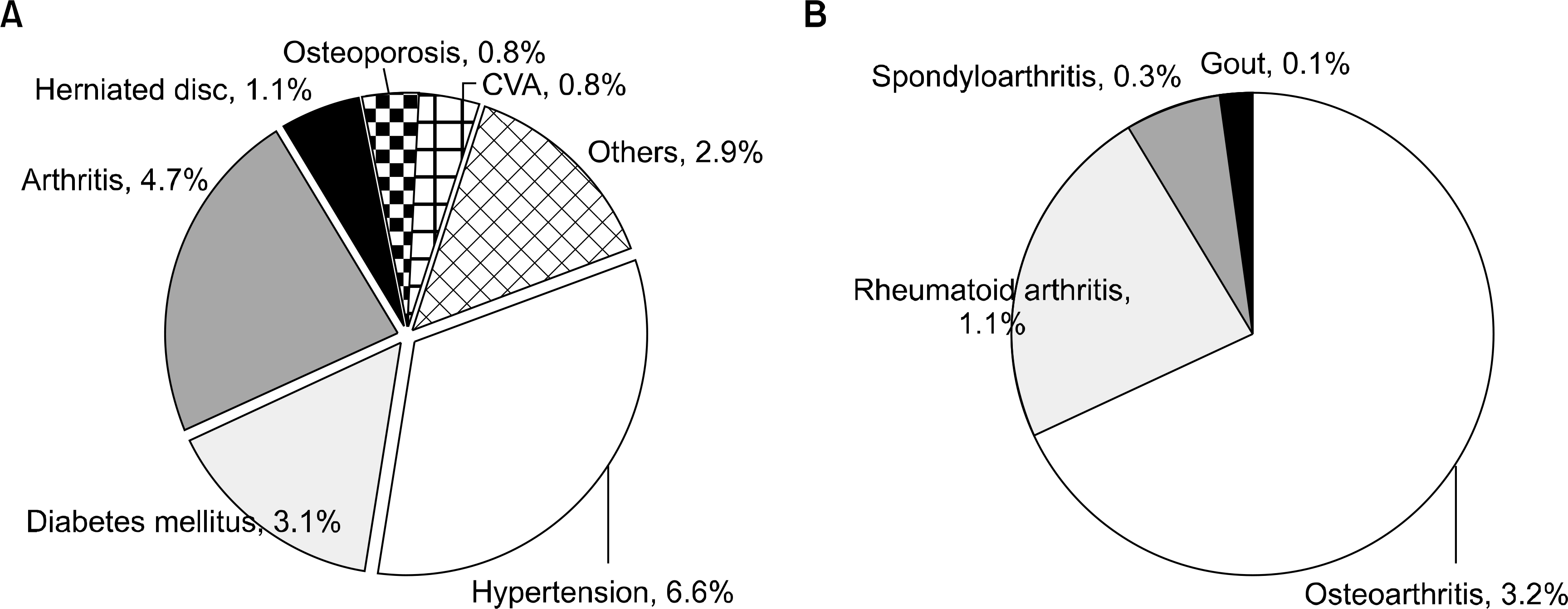
Fig. 2A.
Rheumatoid arthritis. Prevalence rate of rheumatoid arthritis (Fig. 2A) and osteoarthritis (Fig. 2B) in terms of demographic variables in Incheon.
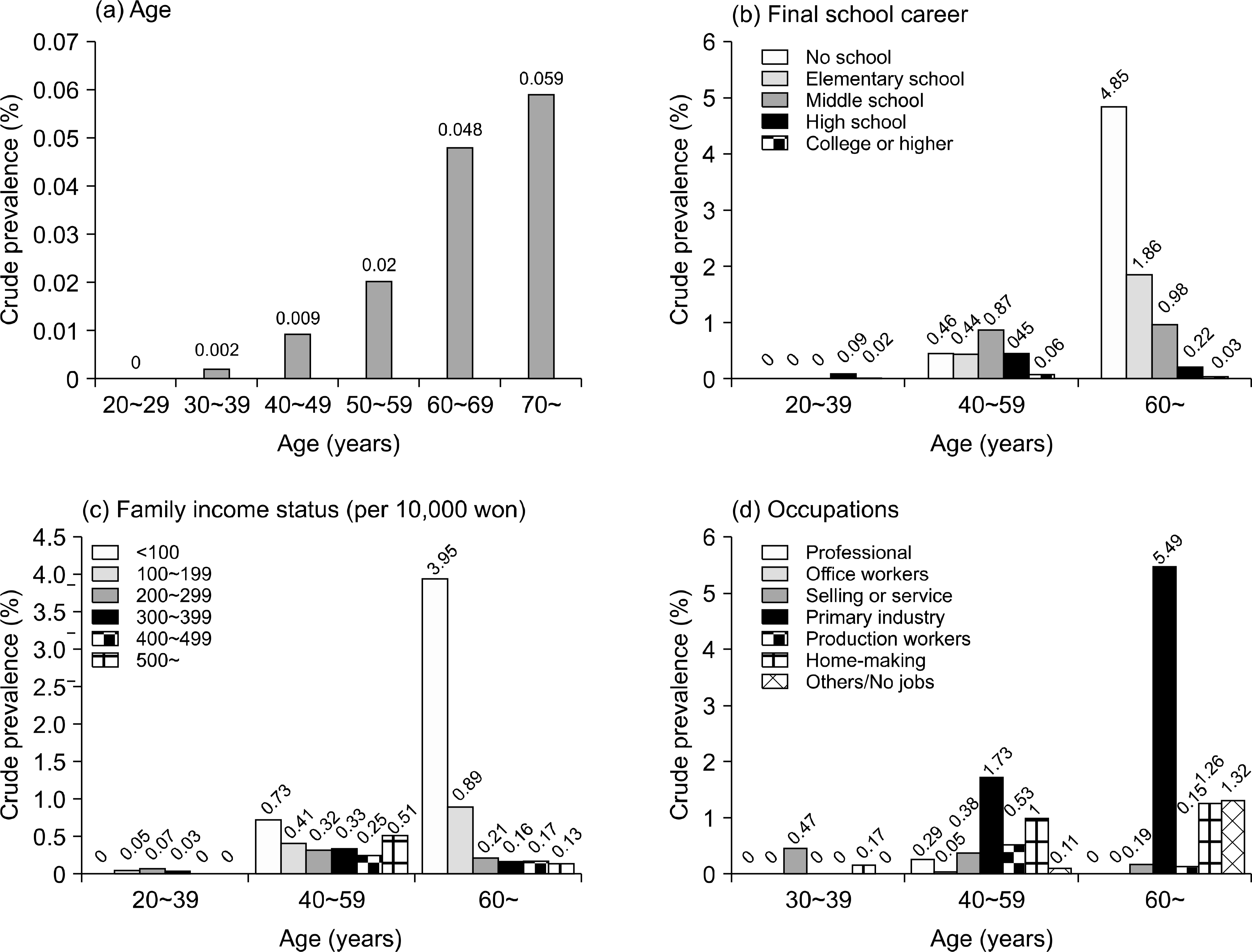
Fig. 2B.
Osteoarthritis. Prevalence rate of rheumatoid arthritis (Fig. 2A) and osteoarthritis (Fig. 2B) in terms of demographic variables in Incheon.
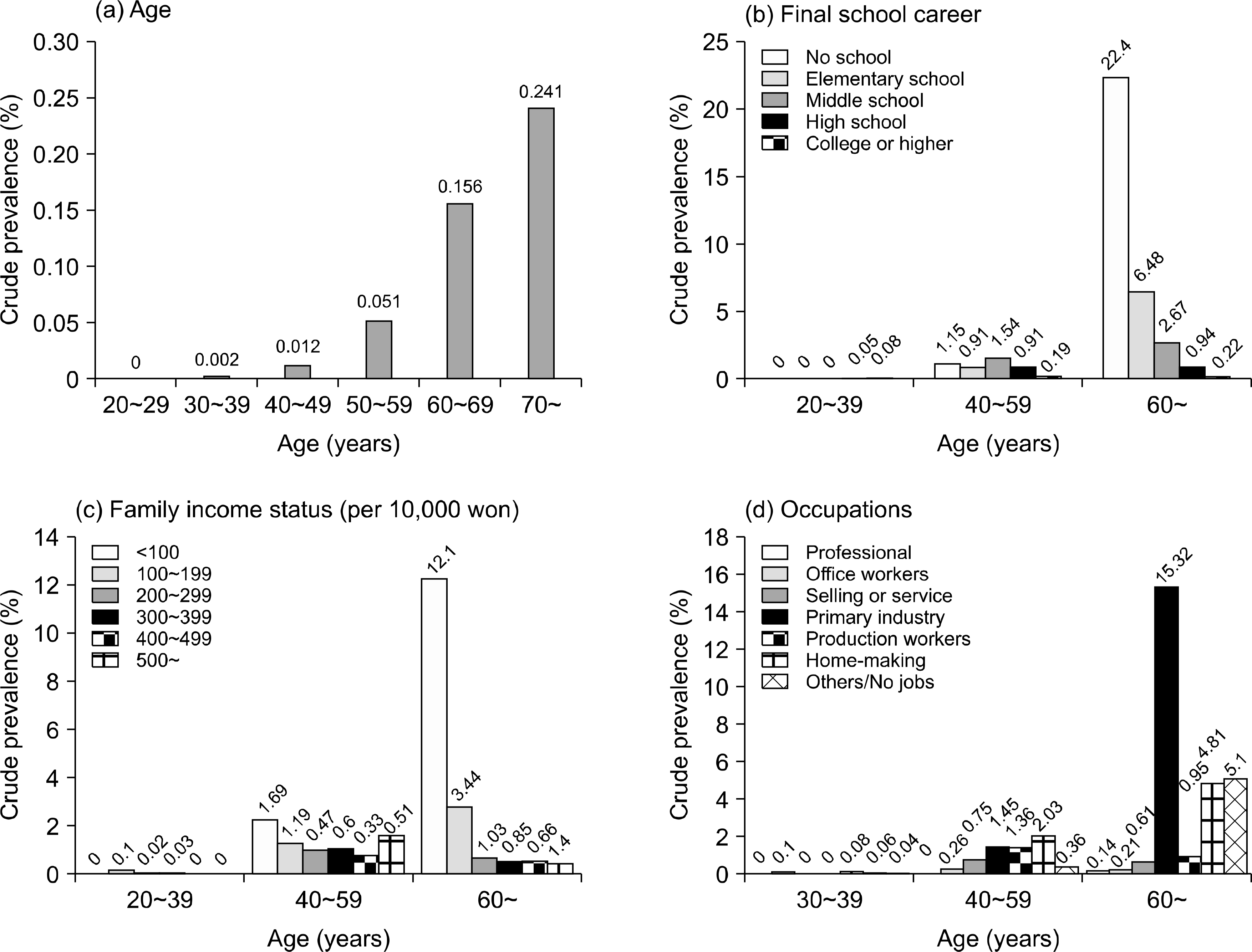
Fig. 3.
Age-adjusted prevalence rate of rheumatoid arthritis (A) and osteoarthritis (B) in each district in Incheon.
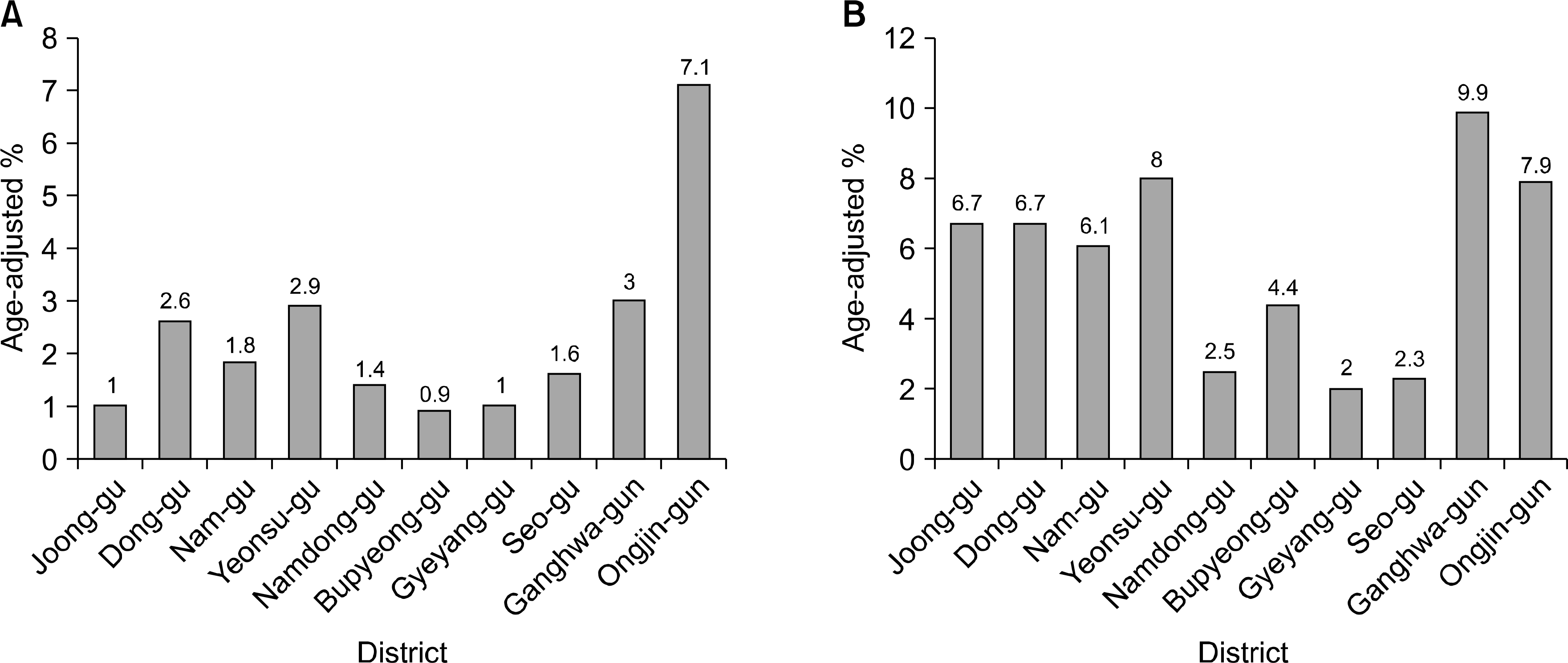
Fig. 4.
Prevalence rate of concurrent chronic diseases in the whole population and patients with rheumatoid arthritis (A) and osteoarthritis (B). CVA: cerebrovascular accident, RA: rheumatoid arthritis, OA: osteoarthritis.
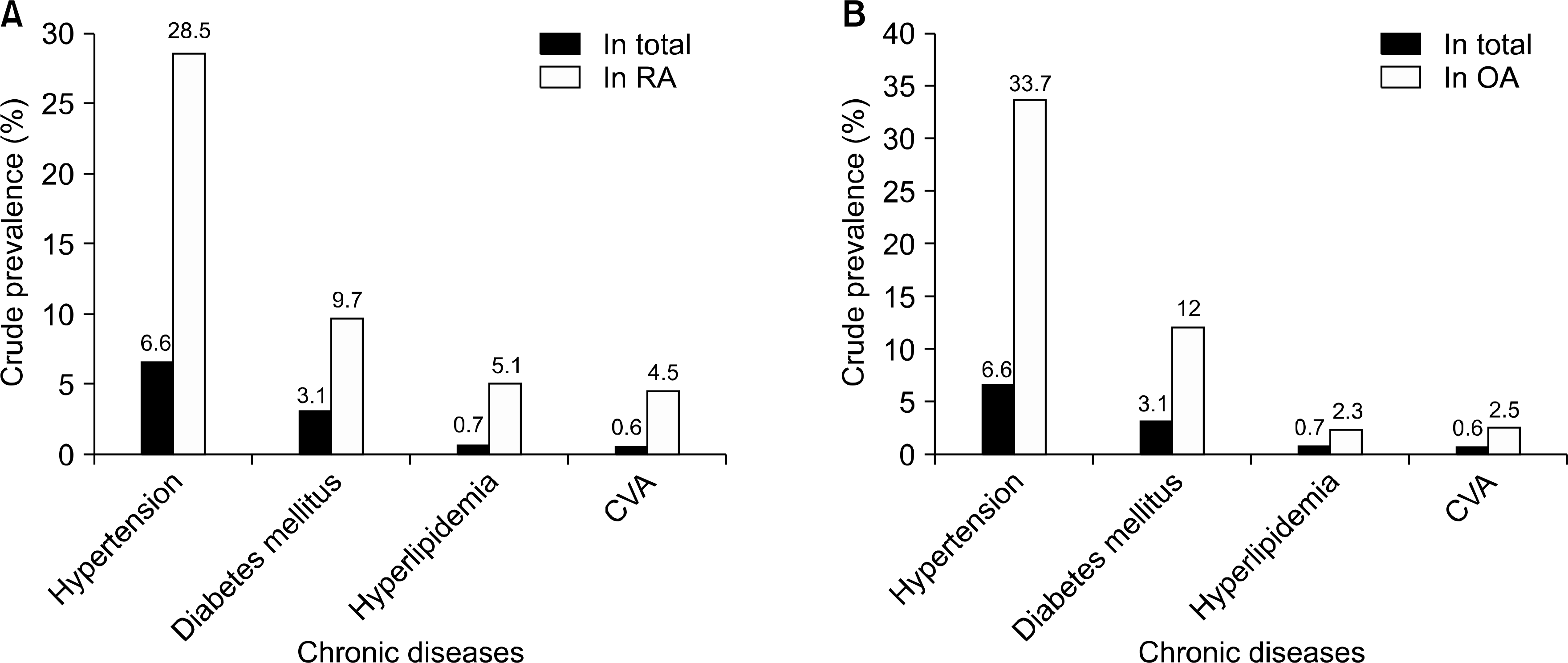
Table 1.
Questionnaire about musculoskeletal or rheumatic disease (근골격계 및 류마티스질환)




 PDF
PDF ePub
ePub Citation
Citation Print
Print


 XML Download
XML Download